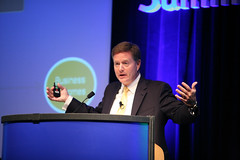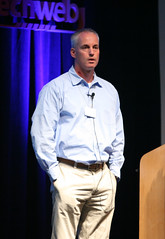The Future looks very Cloudy

 I've just attended the one day, highly-focused executive 'Cloud Summit' conference. The Cloud—used to describe everything from internet-based computing utilities to Software as a Service — was examined and its future impact explored within the highly appropriate venue of the Silicon Valley Computer History Museum.
I've just attended the one day, highly-focused executive 'Cloud Summit' conference. The Cloud—used to describe everything from internet-based computing utilities to Software as a Service — was examined and its future impact explored within the highly appropriate venue of the Silicon Valley Computer History Museum.
The exhibits on the ground floor of the museum are dominated by huge underpowered old computing behemoths, while upstairs in the main conference hall attempts were made to parse the implications of next generation utility computing.
The conference is targeted for executive decision makers, so I was looking forward to hearing strategic and tactical discussion around the pluses and minuses of cloud and SaaS from those in the trenches.
A quick straw poll of attendees in the caffeine breaks proved the economy was top of mind, and the financial upheaval of the last couple of weeks appears to have reset IT management minds grappling with budget constraints to look to the cloud with renewed openness. As 'reduction in force' reports from around the SaaS industry start to appear - an inevitable resetting of resources to weather the attrition of recession and conserve funding - the silver lining is that cloud hosting and associated SaaS apps are arguably in a stronger position than ever based on their ability to deliver a scalable subscription based service that are a better fit for budgets that are being given increasingly short haircuts.
 My quote of the day was from Jeffrey Koser, author of 'Selling to Zebras' in the 'Selling the Cloud to Wall Street and Main Street' session who said "The number one reason executives don't buy software solutions is because they don't believe their staff will be able to operate it". This along with recession induced fear and apathy appear to be the biggest competitors to adoption in an environment hungry for cost effective solutions.
My quote of the day was from Jeffrey Koser, author of 'Selling to Zebras' in the 'Selling the Cloud to Wall Street and Main Street' session who said "The number one reason executives don't buy software solutions is because they don't believe their staff will be able to operate it". This along with recession induced fear and apathy appear to be the biggest competitors to adoption in an environment hungry for cost effective solutions.
Focusing on people and their processes is a far more effective way of selling software as a solution to tactical problems than offering a software package as a cure-all panacea.
 Thomas E. Hogan 'Senior Vice President Hewlett Packard Software' had kicked things off earlier with a strong presentation: the 80/20% mix of consumer to business software is gradually shifting with business taking advantage of the immense innovation of the last few years in the consumer space. Tom cited some amazing statistics: 87 billion emails are sent a day in a digital universe that currently doubles every eighteen months, with net attached devices doubling in number every two years.
Thomas E. Hogan 'Senior Vice President Hewlett Packard Software' had kicked things off earlier with a strong presentation: the 80/20% mix of consumer to business software is gradually shifting with business taking advantage of the immense innovation of the last few years in the consumer space. Tom cited some amazing statistics: 87 billion emails are sent a day in a digital universe that currently doubles every eighteen months, with net attached devices doubling in number every two years.
65% of IT budget goes to operations, and it costs 100 times more to fix problems post software deployment vs at the tactical planning stage. Hogan was clear that HP is very committed to cloud as part of a hybrid approach to service delivery for the enterprise.
To take advantage of this disruptive new paradigm, Hogan recommended taking inventory of your service attributes, build a short and long term service channel strategy to enable a flexible/scalable IT infrastructure for on-premise services.
A common topic in multiple sessions was the concept of private and/or hosted clouds (an example of a private cloud would be GE's Support Central collaboration environment, which has an internal cloud hosting its various tools and technologies).
 Switching gears, John Maddison, VP of Core Technology Solutions at Trend Micro, treated us to Halloween scare stories of criminal usage of the cloud. Security is a subject which strikes fear into the hearts of many an IT executive and is a major barrier to cloud adoption.
Switching gears, John Maddison, VP of Core Technology Solutions at Trend Micro, treated us to Halloween scare stories of criminal usage of the cloud. Security is a subject which strikes fear into the hearts of many an IT executive and is a major barrier to cloud adoption.
In fact John pointed out that existing losses - 60 billion in the US alone - require increasingly huge bandwidth for preventive criminal pattern detection downloads from Trend, and that the cloud is a much more manageable solution to mitigate security risk. Upload and download of over 50,000 criminal patterns is a pricey proposition to physical servers: the $6 billion security market - dominated by Trend, mcAfee and Symantec - all comes down to execution which is easier and less expensive to their clients using the cloud.
The separate issue of protecting company IP and conforming to regulation and compliance such as Sarbanes Oxley came up on the 'Understanding Enterprise Requirements for the Cloud' panel. IT executives can go to jail if their compliance strategy is inadequate, so clarity and options in the event of failure are critical to successful uptake.
In the context of the Computer History Museum it seems inevitable that despite the many planning hurdles still to be overcome the budget attractions of cloud and SaaS will likely render some costly enterprise IT department hosted and run systems obsolete.